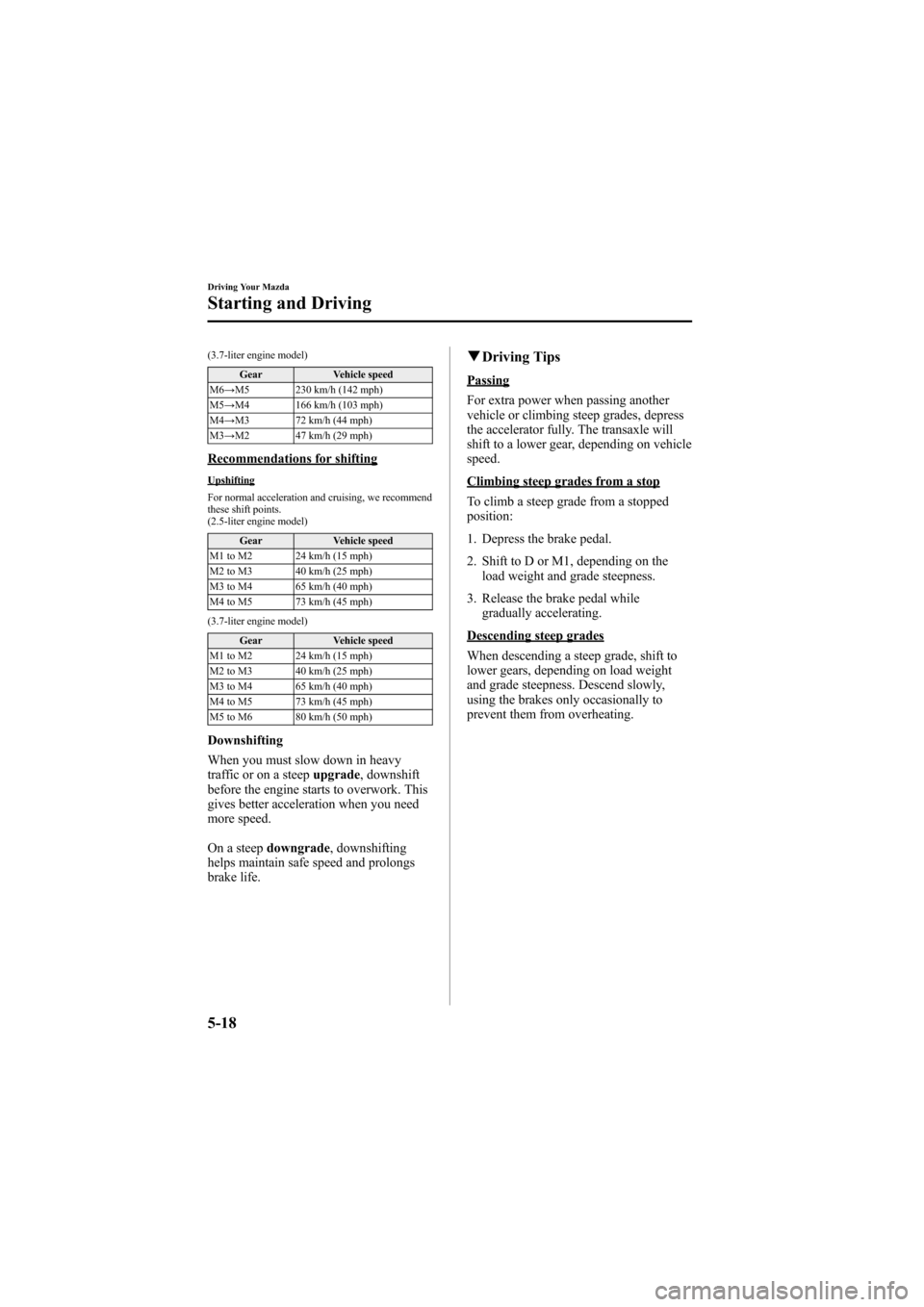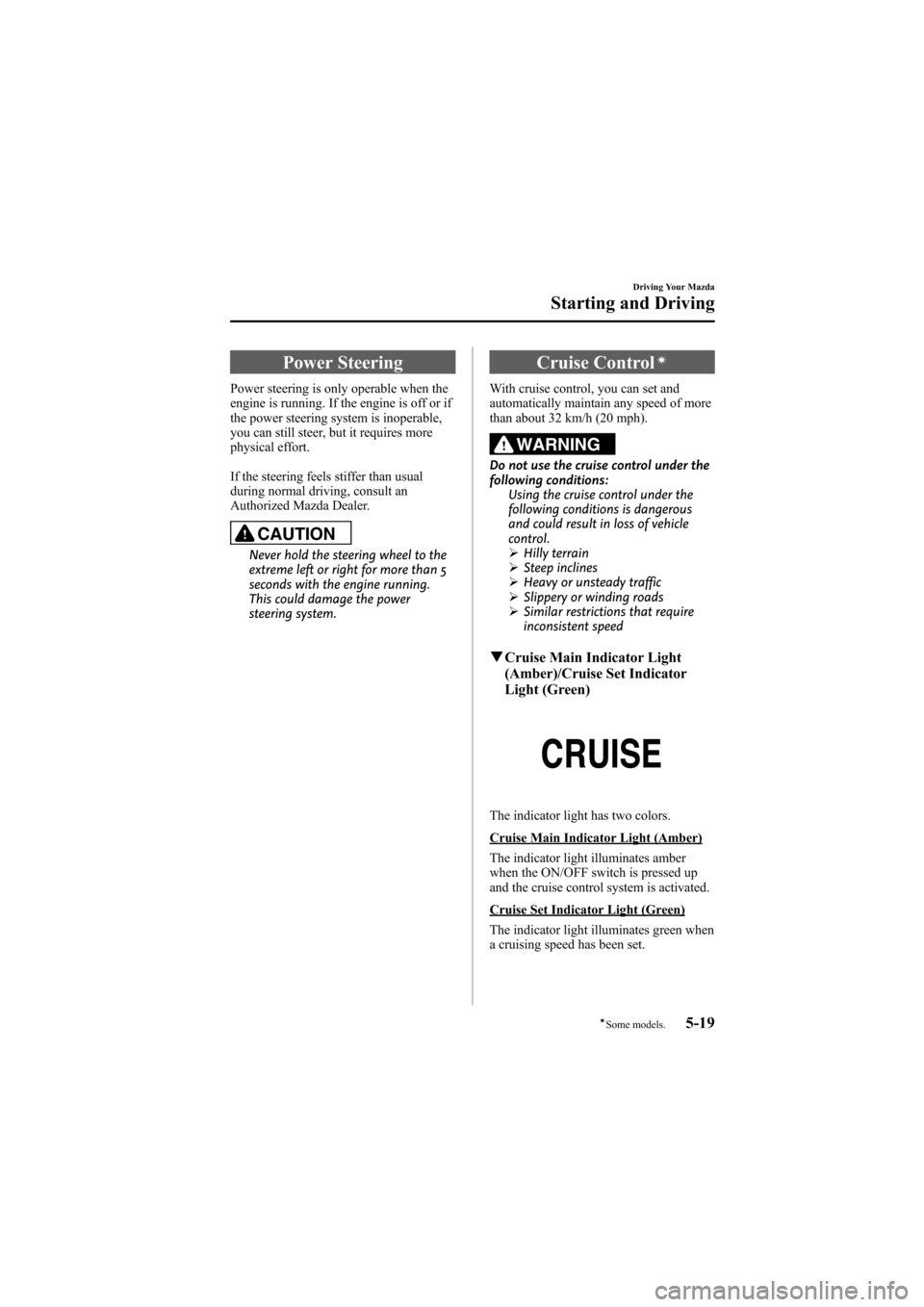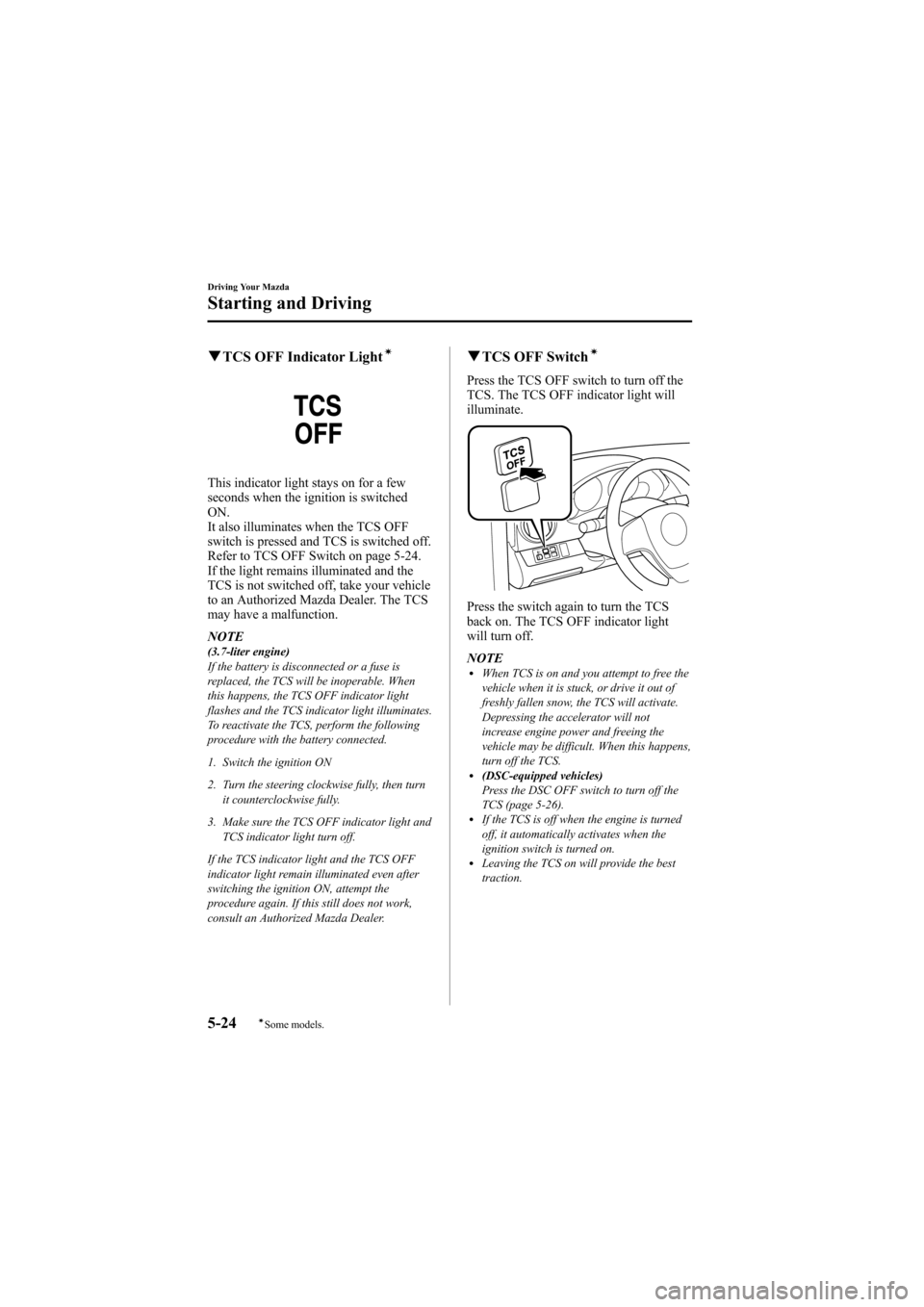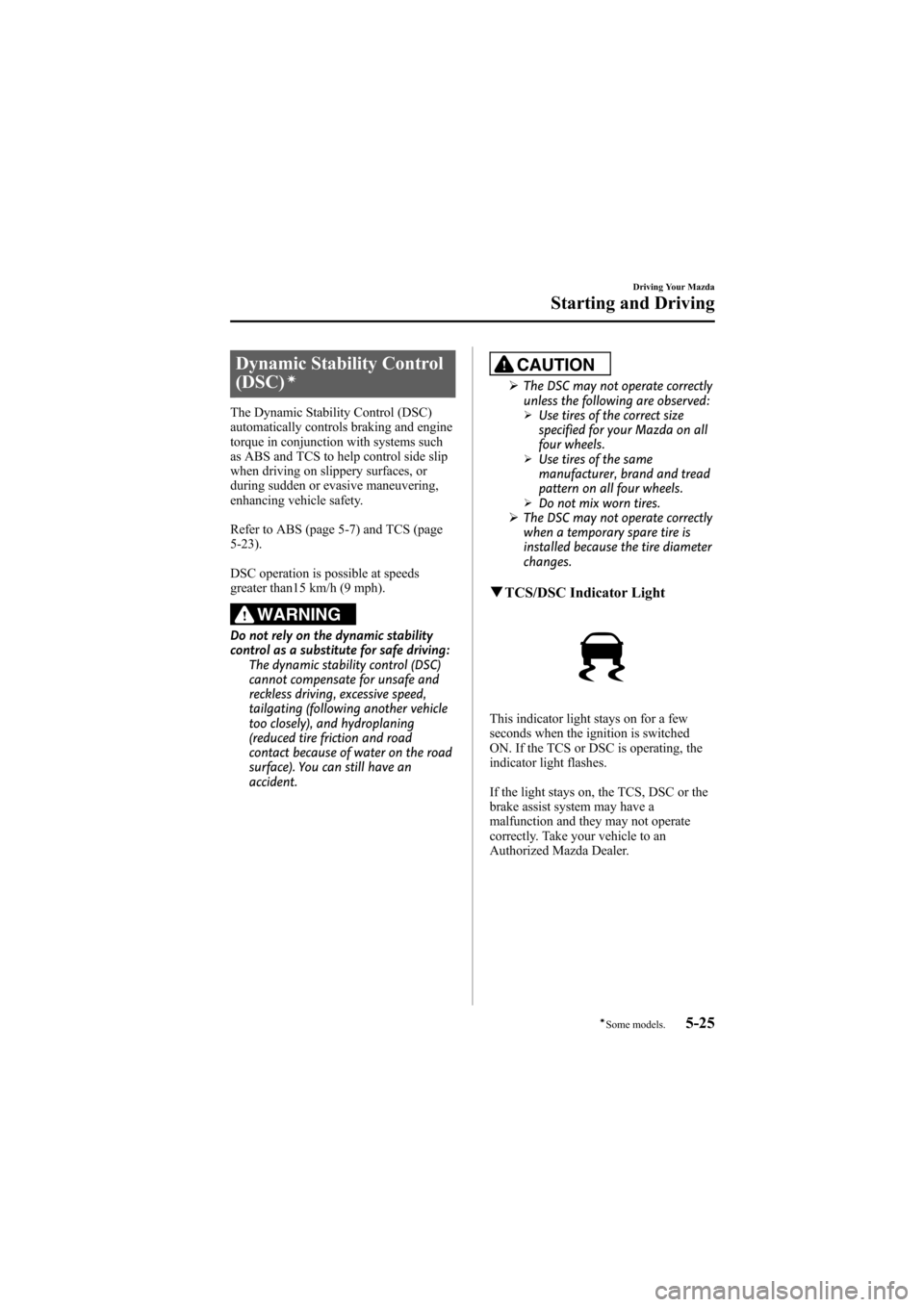engine MAZDA MODEL 6 2009 (in English) Workshop Manual
[x] Cancel search | Manufacturer: MAZDA, Model Year: 2009, Model line: MODEL 6, Model: MAZDA MODEL 6 2009Pages: 464, PDF Size: 4.61 MB
Page 157 of 464

Black plate (157,1)
qTransaxle Ranges
The shift lever must be in P or N to
operate the starter.
P (Park)
P locks the transaxle and prevents the
front wheels from rotating.
WARNING
Always set the shift lever to P and set
the parking brake:
Only setting the shift lever to the P
position without using the parking
brake to hold the vehicle is
dangerous. If P fails to hold, the
vehicle could move and cause an
accident.
CAUTION
ØShifting into P, N or R while the
vehicle is moving can damage
your transaxle.
Ø Shifting into a driving gear or
reverse when the engine is running
faster than idle can damage the
transaxle.
R (Reverse)
In position R, the vehicle moves only
backward. You must be at a complete stop
before shifting to or from R, except under
rare circumstances as explained in
Rocking the Vehicle (page 4-8).
N (Neutral)
In N, the wheels and transaxle are not
locked. The vehicle will roll freely even
on the slightest incline unless the parking
brake or brakes are on.
WARNING
If the engine is running faster than idle,
do not shift from N or P into a driving
gear:
It's dangerous to shift from N or P
into a driving gear when the engine
is running faster than idle. If this is
done, the vehicle could move
suddenly, causing an accident or
serious injury.
Do not shift into N when driving the
vehicle: Shifting into N while driving is
dangerous. Engine braking cannot be
applied when decelerating which
could lead to an accident or serious
injury.
CAUTION
Do not shift into N when driving the
vehicle. Doing so can cause transaxle
damage.
NOTE
Apply the parking brake or depress the brake
pedal before moving the shift lever from N to
prevent the vehicle from moving unexpectedly.
D (Drive)
D is the normal driving position. From a
stop, the transaxle will automatically shift
through a 5-gear/6-gear
*sequence.
* 3.7-liter engine
M (Manual)
M is the manual shift mode position.
Gears can be shifted up or down by
operating the shift lever.
Refer to Manual Shift Mode (page 5-15).
Driving Your Mazda
Starting and Driving
5-13
Mazda6_8Z64-EA-08H_Edition1 Page157
Wednesday, June 25 2008 10:3 AM
Form No.8Z64-EA-08H
Page 158 of 464

Black plate (158,1)
qActive Adaptive Shift (AAS)
Active Adaptive Shift (AAS)
automatically controls the transaxle shift
points to best suit the road conditions and
driver input. This optimizes engine
performance and improves driving
comfort. When cornering the vehicle,
AAS mode will hold the transaxle in the
gear the vehicle was in before entering the
curve, allowing the vehicle to be
accelerated from the same gear after
exiting the curve.
If the driver accelerates rapidly, or
accelerates and decelerates rapidly by
operating the accelerator and brake pedal
for a certain period of time while the
selector lever is in the D position, AAS
mode could activate. When this occurs,
AAS mode will maintain the transaxle in
the optimum gear and the driver may
sense that the transaxle is not shifting,
however this does not indicate an
abnormality.
qShift-Lock System
The shift-lock system prevents shifting
out of P unless the brake pedal is
depressed.
To shift from P:
1. Depress and hold the brake pedal.
2. Start the engine.
3. Move the shift lever. NOTE
lWhen the ignition is switched off (LOCK),
the shift lever cannot be shifted from P.
lTo be sure the vehicle is in park,
the
ignition key cannot be removed unless the
shift lever is in P.
l(With Advanced Key)
The ignition cannot be switched from ACC
to off (LOCK) when the shift lever is not in
P.
q Shift-Lock Override
If the shift lever will not move from P
using the proper shift procedure, continue
to hold down the pedal.
1. Remove the shift-lock override cover
using a cloth-wrapped flat head
screwdriver.
2. Insert a screwdriver and push it down.
Cover
3. Move the shift lever.
4. Take the vehicle to an Authorized Mazda Dealer to have the system
checked.
5-14
Driving Your Mazda
Starting and Driving
Mazda6_8Z64-EA-08H_Edition1 Page158
Wednesday, June 25 2008 10:3 AM
Form No.8Z64-EA-08H
Page 159 of 464

Black plate (159,1)
qManual Shift Mode
This mode gives you the feel of driving a
manual transaxle vehicle by operating the
shift lever and allows you to control
engine rpm and torque to the front wheels
much like a manual transaxle when more
control is desired.
To change to manual shift mode, shift the
lever from D to M.
NOTE
Changing to manual mode can be done while
driving the vehicle with no damage occurring
to the transaxle.
To return to automatic shift mode, shift
the lever from M to D.
NOTE
lIf you change to manual shift mode when
the vehicle is stopped, the gear will shift to
M1.
l(2.5-liter engine model)
If you change to manual shift mode without
depressing the accelerator pedal when
driving in D range, 5th gear, the gear will
shift to M4.
Indicators
Shift position indicator
In manual shift mode, the “M ”of the shift
position indicator in the instrument panel
illuminates.
Gear position indicator
The numeral for the selected gear
illuminates.
Shift position indicator
D range/gear position indicator
NOTElIf the gears cannot be shifted down when
driving at higher speeds, the gear position
indicator will flash twice to signal that the
gears cannot be shifted down.
l(2.5-liter engine model)
If the automatic transaxle fluid (ATF)
temperature becomes too high, there is the
possibility that the transaxle will switch to
automatic shift mode, canceling manual
shift mode and turning off the gear position
indicator illumination. This is a normal
function to protect the AT. After the ATF
temperature has decreased, the gear
position indicator illumination turns back
on and driving in manual shift mode is
restored.
Driving Your Mazda
Starting and Driving
5-15
Mazda6_8Z64-EA-08H_Edition1 Page159
Wednesday, June 25 2008 10:3 AM
Form No.8Z64-EA-08H
Page 160 of 464

Black plate (160,1)
Shifting
Manually Shifting up
(M1→M2 →M3 →M4 →M5 →M6
í)
To shift up to a higher gear, tap the shift
lever back (
) once.
NOTElWhen driving slowly, the gears may not
shift up depending on vehicle speed.
lIn manual shift mode, gears do not shift up
automatically. Do not run the engine with
the tachometer needle in the RED ZONE. If
the tachometer needle enters the RED
ZONE, you may feel engine-braking
because the fuel delivery will be stopped to
protect the engine. However, this does not
indicate an abnormality.
lWhen depressing the accelerator fully, the
transaxle will shift to a lower gear,
depending on vehicle speed.
Manually Shifting down
(M6í→ M5 →M4 →M3 →M2 →M1)
To shift down to a lower gear, tap the shift
lever forward (
) once.
WARNING
Do not use engine braking on slippery
road surfaces or at high speeds: Shifting down while driving on wet,
snowy, or frozen roads, or while
driving at high speeds causes sudden
engine braking, which is dangerous.
The sudden change in tire speed
could cause the tires to skid. This
could lead to loss of vehicle control
and an accident.
NOTE
lWhen driving at high speeds, the gear may
not shift down depending on vehicle speed.
lDuring deceleration, the gear may
automatically shift down depending on
vehicle speed.
lWhen depressing the accelerator fully, the
transaxle will shift to a lower gear,
depending on vehicle speed.
5-16
Driving Your Mazda
íSome models.
Starting and Driving
Mazda6_8Z64-EA-08H_Edition1 Page160
Wednesday, June 25 2008 10:3 AM
Form No.8Z64-EA-08H
Page 161 of 464

Black plate (161,1)
Second gear fixed mode
When the shift lever is tapped back (
)
while the vehicle is stopped or driven at
about 10 km/h (6 mph) or less, the
transaxle is set in the second gear fixed
mode. The gear is fixed in second while in
this mode for easier starting and driving
on slippery roads. If the shift lever is
tapped back (
) or forward () while in
the second gear fixed mode, the mode will
be canceled.
Shifting specification
Shifting up
If the vehicle speed is lower than the speed specified
for each gear, the gear cannot be shifted up to a
higher gear.
(2.5-liter engine model)
Gear Vehicle speed
M1 →M2 You can shift up to M2 whether
the vehicle is stopped or
moving.
M2 →M3 20.5 km/h (12.8 mph)
M3 →M4 33.9 km/h (21.1 mph)
M4 →M5 34.1 km/h (21.2 mph)
(3.7-liter engine model)
Gear Vehicle speed
M1 →M2 You can shift up to M2 whether
the vehicle is stopped or
moving.
M2 →M3 15 km/h (10 mph)
M3 →M4 30.8 km/h (19.2 mph)
M4 →M5 42.1 km/h (26.2 mph)
M5 →M6 54.4 km/h (33.9 mph) Shifting down
If the vehicle speed is higher than the speed specified
for each gear, the gear cannot be shifted to a lower
gear so as to protect the transaxle.
(2.5-liter engine model)
Gear Vehicle speed
M5 →M4 190 km/h (118 mph)
M4 →M3 135.1 km/h (83.9 mph)
M3 →M2 89.7 km/h (55.7 mph)
M2 →M1 44.9 km/h (27.8 mph)
(3.7-liter engine model)
Gear Vehicle speed
M6 →M5 230 km/h (142 mph)
M5 →M4 187.3 km/h (116.3 mph)
M4 →M3 130 km/h (80 mph)
M3 →M2 82 km/h (50 mph)
M2 →M1 40.7 km/h (25.2 mph)
During deceleration, the gears shift down
automatically when speed is reduced to the
following:
(2.5-liter engine model)
Gear Vehicle speed
M5 or M4 →M3 30.8 km/h (19.1 mph)
M3 or M2 →M1 10 km/h (6 mph)
(3.7-liter engine model) Gear Vehicle speed
M6 →M5 51.4 km/h (31.9 mph)
M5 →M4 39.1 km/h (24.2 mph)
M4 →M3 27.8 km/h (17.2 mph)
M3 or M2 →M1 7.2 km/h (4.4 mph)
NOTEThe gear does not shift down to M1
automatically while in the second gear fixed
mode.
If the vehicle is kicked down at the following speeds
or lower, the gears shift down automatically:
(2.5-liter engine model)
Gear Vehicle speed
M5 →M4 180 km/h (111 mph)
M4 →M3 126 km/h (78 mph)
M3 →M2 49.4 km/h (30.6 mph)
Driving Your Mazda
Starting and Driving
5-17
Mazda6_8Z64-EA-08H_Edition1 Page161
Wednesday, June 25 2008 10:4 AM
Form No.8Z64-EA-08H
Page 162 of 464

Black plate (162,1)
(3.7-liter engine model)Gear Vehicle speed
M6 →M5 230 km/h (142 mph)
M5 →M4 166 km/h (103 mph)
M4 →M3 72 km/h (44 mph)
M3 →M2 47 km/h (29 mph)
Recommendations for shifting
Upshifting
For normal acceleration and cruising, we recommend
these shift points.
(2.5-liter engine model)
Gear Vehicle speed
M1 to M2 24 km/h (15 mph)
M2 to M3 40 km/h (25 mph)
M3 to M4 65 km/h (40 mph)
M4 to M5 73 km/h (45 mph)
(3.7-liter engine model) Gear Vehicle speed
M1 to M2 24 km/h (15 mph)
M2 to M3 40 km/h (25 mph)
M3 to M4 65 km/h (40 mph)
M4 to M5 73 km/h (45 mph)
M5 to M6 80 km/h (50 mph)
Downshifting
When you must slow down in heavy
traffic or on a steep upgrade, downshift
before the engine starts to overwork. This
gives better acceleration when you need
more speed.
On a steep downgrade , downshifting
helps maintain safe speed and prolongs
brake life.
q Driving Tips
Passing
For extra power when passing another
vehicle or climbing steep grades, depress
the accelerator fully. The transaxle will
shift to a lower gear, depending on vehicle
speed.
Climbing steep grades from a stop
To climb a steep grade from a stopped
position:
1. Depress the brake pedal.
2. Shift to D or M1, depending on the
load weight and grade steepness.
3. Release the brake pedal while gradually accelerating.
Descending steep grades
When descending a steep grade, shift to
lower gears, depending on load weight
and grade steepness. Descend slowly,
using the brakes only occasionally to
prevent them from overheating.
5-18
Driving Your Mazda
Starting and Driving
Mazda6_8Z64-EA-08H_Edition1 Page162
Wednesday, June 25 2008 10:4 AM
Form No.8Z64-EA-08H
Page 163 of 464

Black plate (163,1)
Power Steering
Power steering is only operable when the
engine is running. If the engine is off or if
the power steering system is inoperable,
you can still steer, but it requires more
physical effort.
If the steering feels stiffer than usual
during normal driving, consult an
Authorized Mazda Dealer.
CAUTION
Never hold the steering wheel to the
extreme left or right for more than 5
seconds with the engine running.
This could damage the power
steering system.
Cruise Controlí
With cruise control, you can set and
automatically maintain any speed of more
than about 32 km/h (20 mph).
WARNING
Do not use the cruise control under the
following conditions:Using the cruise control under the
following conditions is dangerous
and could result in loss of vehicle
control.
ØHilly terrain
Ø Steep inclines
Ø Heavy or unsteady traffic
Ø Slippery or winding roads
Ø Similar restrictions that require
inconsistent speed
qCruise Main Indicator Light
(Amber)/Cruise Set Indicator
Light (Green)
The indicator light has two colors.
Cruise Main Indicator Light (Amber)
The indicator light illuminates amber
when the ON/OFF switch is pressed up
and the cruise control system is activated.
Cruise Set Indicator Light (Green)
The indicator light illuminates green when
a cruising speed has been set.
Driving Your Mazda
Starting and Driving
5-19íSome models.
Mazda6_8Z64-EA-08H_Edition1 Page163
Wednesday, June 25 2008 10:4 AM
Form No.8Z64-EA-08H
Page 167 of 464

Black plate (167,1)
Traction Control System
(TCS)
The Traction Control System (TCS)
enhances traction and safety by
controlling engine torque and braking
*.
When the TCS detects driving wheel
slippage, it lowers engine torque and
operates the brakes
*to prevent loss of
traction.
This means that on a slick surface, the
engine adjusts automatically to provide
optimum power to the drive wheels
without causing them to spin and lose
traction.
* DSC-equipped vehicles only
WARNING
Do not rely on the traction control
system as a substitute for safe driving: The traction control system (TCS)
cannot compensate for unsafe and
reckless driving, excessive speed,
tailgating (following another vehicle
too closely), and hydroplaning
(reduced tire friction and road
contact because of water on the road
surface). You can still have an
accident.
Use snow tires and drive at reduced
speeds when roads are covered with ice
and/or snow: Driving without proper traction
devices on snow and/or ice-covered
roads is dangerous. The traction
control system (TCS) alone cannot
provide adequate traction and you
could still have an accident.
qTCS/DSC Indicator Light
This indicator light stays on for a few
seconds when the ignition is switched
ON. If the TCS or DSC
*is operating, the
indicator light flashes.
If the light stays on, the TCS, DSC
*or the
brake assist system*may have a
malfunction and they may not operate
correctly. Take your vehicle to an
Authorized Mazda Dealer.
*DSC-equipped vehicles only
NOTE
lIn addition to the indicator light flashing, a
slight lugging sound will come from the
engine. This indicates that the TCS is
operating properly.
lOn slippery surfaces, such as fresh snow, it
will be impossible to achieve high rpm
when the TCS is on.
Driving Your Mazda
Starting and Driving
5-23
Mazda6_8Z64-EA-08H_Edition1 Page167
Wednesday, June 25 2008 10:4 AM
Form No.8Z64-EA-08H
Page 168 of 464

Black plate (168,1)
qTCS OFF Indicator Lightí
This indicator light stays on for a few
seconds when the ignition is switched
ON.
It also illuminates when the TCS OFF
switch is pressed and TCS is switched off.
Refer to TCS OFF Switch on page 5-24.
If the light remains illuminated and the
TCS is not switched off, take your vehicle
to an Authorized Mazda Dealer. The TCS
may have a malfunction.
NOTE
(3.7-liter engine)
If the battery is disconnected or a fuse is
replaced, the TCS will be inoperable. When
this happens, the TCS OFF indicator light
flashes and the TCS indicator light illuminates.
To reactivate the TCS, perform the following
procedure with the battery connected.
1. Switch the ignition ON
2. Turn the steering clockwise fully, then turn
it counterclockwise fully.
3. Make sure the TCS OFF indicator light and TCS indicator light turn off.
If the TCS indicator light and the TCS OFF
indicator light remain illuminated even after
switching the ignition ON, attempt the
procedure again. If this still does not work,
consult an Authorized Mazda Dealer.
q TCS OFF Switchí
Press the TCS OFF switch to turn off the
TCS. The TCS OFF indicator light will
illuminate.
Press the switch again to turn the TCS
back on. The TCS OFF indicator light
will turn off.
NOTE
lWhen TCS is on and you attempt to free the
vehicle when it is stuck, or drive it out of
freshly fallen snow, the TCS will activate.
Depressing the accelerator will not
increase engine power and freeing the
vehicle may be difficult. When this happens,
turn off the TCS.
l(DSC-equipped vehicles)
Press the DSC OFF switch to turn off the
TCS (page 5-26).
lIf the TCS is off when the engine is turned
off, it automatically activates when the
ignition switch is turned on.
lLeaving the TCS on will provide the best
traction.
5-24
Driving Your Mazda
íSome models.
Starting and Driving
Mazda6_8Z64-EA-08H_Edition1 Page168
Wednesday, June 25 2008 10:4 AM
Form No.8Z64-EA-08H
Page 169 of 464

Black plate (169,1)
Dynamic Stability Control
(DSC)í
The Dynamic Stability Control (DSC)
automatically controls braking and engine
torque in conjunction with systems such
as ABS and TCS to help control side slip
when driving on slippery surfaces, or
during sudden or evasive maneuvering,
enhancing vehicle safety.
Refer to ABS (page 5-7) and TCS (page
5-23).
DSC operation is possible at speeds
greater than15 km/h (9 mph).
WARNING
Do not rely on the dynamic stability
control as a substitute for safe driving:The dynamic stability control (DSC)
cannot compensate for unsafe and
reckless driving, excessive speed,
tailgating (following another vehicle
too closely), and hydroplaning
(reduced tire friction and road
contact because of water on the road
surface). You can still have an
accident.
CAUTION
ØThe DSC may not operate correctly
unless the following are observed:
ØUse tires of the correct size
specified for your Mazda on all
four wheels.
ØUse tires of the same
manufacturer, brand and tread
pattern on all four wheels.
ØDo not mix worn tires.
Ø The DSC may not operate correctly
when a temporary spare tire is
installed because the tire diameter
changes.
qTCS/DSC Indicator Light
This indicator light stays on for a few
seconds when the ignition is switched
ON. If the TCS or DSC is operating, the
indicator light flashes.
If the light stays on, the TCS, DSC or the
brake assist system may have a
malfunction and they may not operate
correctly. Take your vehicle to an
Authorized Mazda Dealer.
Driving Your Mazda
Starting and Driving
5-25íSome models.
Mazda6_8Z64-EA-08H_Edition1 Page169
Wednesday, June 25 2008 10:4 AM
Form No.8Z64-EA-08H